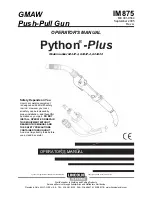
10
REFRIGERANT PIPING —
When connecting refrigerant piping from an indoor unit to an
outdoor unit, follow these guidelines:
• Check the maximum height drop and length of
refrigerant piping between the indoor and outdoor units.
To ensure the drop and length are acceptable, refer to the
refrigerant piping allowable limits in the outdoor unit
installation manual.
• The number of bends in the refrigeration piping must be
fewer than 15.
• Refrigerant piping connection between indoor and
outdoor units should be performed once the units are
secured at their respective installation locations.
• The refrigeration piping starts at the indoor unit and ends
at the outdoor unit or Multi-port Distribution Controller
(MDC) (Heat Recovery systems).
• The refrigerant piping should be dry and free of dust and
other impurities.
• The bending angle of the refrigerant pipe should not
exceed 90
and the bending radius should be as large as
possible to prevent any breakage in piping.
• Use proper cutting and flaring tools to avoid leakage.
• Use a torque wrench for flare nuts. Refer to Table 3 for
flare nut torque recommendations.
Table 3 —Flare Nut Torque Recommendations
• Before insulating the suction and liquid refrigeration
pipes, perform pressure and leak tests. For details, see
the outdoor unit installation manual. Insulating both
suction and liquid refrigerant pipes is mandatory.
• Vacuuming and charging of the system should be carried
out as described in the outdoor unit installation manual.
Step 5 — Complete the Electrical
Connections —
Installation of wiring must conform with
local building codes and with National Electric Code ANSI/
NFPA 70, current editions. Units must be electrically grounded
in conformance with the code. In Canada, wiring must comply
with CSA C22.1, Electrical Code.
This equipment in its standard form is designed for an
electrical supply of 208/230-1-60. Any damage to or failure of
units caused by incorrect wiring or voltage is not covered by
the warranty.
Electric wiring must be sized to carry the full load amp draw of
the motor, starter, and any other controls that are used with the
unit. See Table 4 for electrical data.
Table 4 —40VMZ Electrical Data
LEGEND
MCA - Minimum Circuit Amps
MOPD - Maximum Overcurrent Protective Device
After the pipe work is complete, the electrical supply can be
connected by routing the cable through the appropriate casing
holes or knockouts and connecting the supply and ground
cables to the unit’s power terminal.
Be sure the power wiring and control wiring do not cross, as
this might cause disturbance on the controls side. See Fig. 15
NOTE:
The indoor unit requires its own power supply. Indoor
units are not powered through outdoor units.
CAUTION
When connecting from an indoor unit to an outdoor unit,
the isolation valve at outdoor unit should be in closed
position throughout the refrigerant piping process.
Failure to follow this procedure may result in equipment
damage.
Outside Diameter
Recommended Torque (FT-LB)
1
/
4
15
3
/
8
26
1
/
2
41
5
/
8
48
WARNING
Electrical shock can cause personal injury or death.
Disconnect the power supply before making wiring
connections. There may be more than one disconnect
switch. Tag all disconnect locations to alert others not to
restore power until work is completed.
WARNING
All units must be wired strictly in accordance with the
wiring diagram furnished with the unit. Any wiring
different from the wiring diagram could result in
personal injury and property damage.
CAUTION
Any original factory wiring that requires replacement
must be replaced with wiring material having a
temperature rating of at least 105ºC.
Ensure supply voltage to the unit, as indicated on the
serial plate, is not more than 10% over the rated voltage
or 10% under the rated voltage.
Failure to follow these recommendations may result in
equipment damage.
40VMZ Unit Size
Power Supply
MCA
MOPD
40VMZ009---3
0.88
15
40VMZ012---3
1.40
40VMZ015---3
1.40
40VMZ018---3
1.90
40VMZ024---3
2.50








































